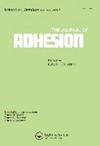不同温度下粘结缺陷对单搭接接头强度和蠕变性能影响的实验研究
IF 2.3
4区 材料科学
Q2 ENGINEERING, CHEMICAL
引用次数: 14
摘要
摘要本文研究了含有缺陷的单搭接胶接接头的蠕变行为和强度,并研究了缺陷位置对其蠕变行为和性能的影响。在Araldite 2011粘合剂层的各个侧面上产生缺陷,并对接头进行拉伸和蠕变测试。蠕变试验在三种不同的温度下进行;23℃(室温)、45℃和55℃。结果表明,粘合剂层中缺陷的存在导致缺陷接头中接头强度的最大降低,缺陷在中间和两侧。此外,粘合剂层中缺陷的存在增加了蠕变位移,蠕变位移远高于没有缺陷的接头中的这种位移量。将温度提高到45℃和55℃,与室温下的蠕变位移相比,蠕变位移增加了近90%。根据结果,两侧缺陷的存在对降低接头强度(中间缺陷)和增加蠕变位移(边缘缺陷)的影响最大。本文章由计算机程序翻译,如有差异,请以英文原文为准。
Experimental investigation of the effects of adhesive defects on the strength and creep behavior of single-lap adhesive joints at various temperatures
ABSTRACT In this article, the creep behavior and strength of single-lap adhesive joints ( s) including defects have been studied, and the effect of the position of defects on the creep behavior and strength of s have been investigated. The defects were created on various sides of the Araldite 2011 adhesive layer and joints were subjected to the tensile and creep tests. The creep tests were done at three different temperatures; 23 ℃ (Room Temperature), 45 ℃, and 55 ℃. The results showed that the presence of a defect in the adhesive layer caused the greatest decrease in the strength of the joints in the defective joint with the defect in the middle and both sides. Also, the presence of a defect in the adhesive layer increases the creep displacement, which is much higher than the amount of this displacement in the joint without a defect. Increasing temperature to 45 ℃, and 55 ℃ has increased the creep displacement by almost 90%, compared to the creep displacement at room temperature (RT). Based on the results, the presence of defects on both sides has the greatest effect on reducing the strength of the joint (defect in the middle) and increasing the creep displacement (defect in the edge).
求助全文
通过发布文献求助,成功后即可免费获取论文全文。
去求助
来源期刊

Journal of Adhesion
工程技术-材料科学:综合
CiteScore
5.30
自引率
9.10%
发文量
55
审稿时长
1 months
期刊介绍:
The Journal of Adhesion is dedicated to perpetuating understanding of the phenomenon of adhesion and its practical applications. The art of adhesion is maturing into a science that requires a broad, coordinated interdisciplinary effort to help illuminate its complex nature and numerous manifestations.
 求助内容:
求助内容: 应助结果提醒方式:
应助结果提醒方式:


